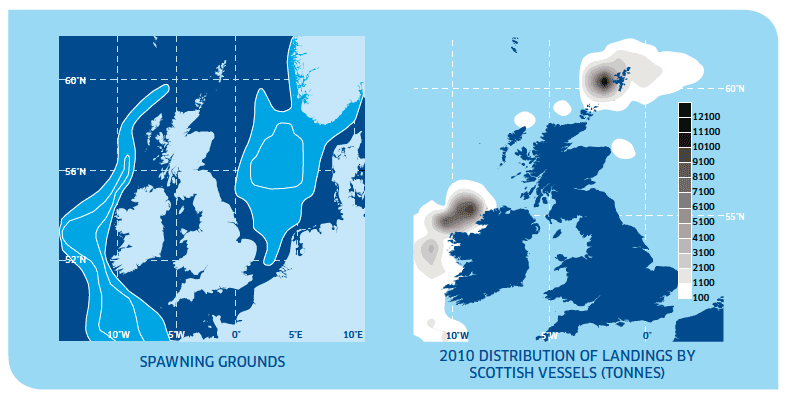Fish and Shellfish Stocks 2012
Fish and Shellfish Stocks 2012. State of Scottish fish stocks, TACs and biology of the stocks for 2012.
SCOTTISH FISH STOCKS
NORTHEAST ATLANTIC MACKEREL STOCKS
Mackerel ( Scomber scombrus) is the most important pelagic species for the Scottish fishing industry. It is caught predominantly with pelagic trawl mainly in western waters and the North Sea.
2012 position : UK share 152,368 tonnes
Last Year : 189,694 tonnes
Landed into Scotland in 2010 : 95,180 tonnes
Value for 2010 : £78 million
Biology
The mackerel ( Scomber scombrus) caught by the Scottish pelagic fleet belong to two different stocks - the North Sea and the western. This separation is based on differences in the timing and the areas used for spawning. North Sea mackerel overwinter in the deep water, to the east and north of Shetland and on the edge of the Norwegian Deep. In the springtime, they migrate south to spawn in the central part of the North Sea from May until July. The western mackerel stock is found near to the continental slope, over a vast area. These fish spawn between March and July, mainly to the south and west of the UK and Ireland. When spawning is finished, most of the spent fish move to the feeding grounds in the Norwegian Sea and the northern North Sea where they mix with the North Sea stock. Some western stock mackerel, predominantly small individuals, also enter the North Sea through the English Channel. The western stock mackerel travel long distances between the feeding grounds and the spawning areas. Over the past twenty years, the pattern of their southerly migration has changed dramatically in both timing and route. In the 1970s and 1980s this movement occurred in late summer and autumn with the fish passing through the relatively shallow waters of the Minch. Now the migration occurs gradually later in the year and is further offshore. The pattern of the return northerly journey, after spawning, has remained relatively constant. The boundaries of the spawning areas have also slowly changed, with an increase in spawning activity in the north of the area and to the west of the shelf edge.
By the time they reach three years old, most mackerel are mature. At one year old, only a small proportion of females are mature and able to spawn, while more than half can spawn at two years old. Female mackerel shed their eggs in about twenty separate batches over the course of a spawning season. An average-sized fish produces around 250,000 eggs. Juvenile mackerel grow quickly and can reach 22cm after one year and 30cm after two years.
The diet of mackerel can vary with the area and the season. By weight, almost half of the food consists of crustacea (shrimps). The remainder is made up of juvenile fish such as sandeel, herring and Norway pout.

ICES ADVICE ON MANAGEMENT
Information Source: ICES advice 2011 ( http://www.ices.dk/committe/acom/comwork/report/2011/2011/mac-nea.pdf). Quoted text in italics

MSY and precautionary approach reference points
|
|
Type |
Value |
|---|---|---|
| Management plan |
SSB trigger |
2.2 million t |
| F target |
0.20-0.22 |
|
| MSY Approach |
MSY B trigger |
2.2 million t |
| F msy |
0.22 |
|
| Precautionary Approach |
B lim |
1.67 million t |
| B pa |
2.3 million t |
|
| F lim |
0.42 |
|
| F pa |
0.23 |
State of stock and advice
- Fishing mortality in 2010 is estimated to be 0.26: this means that approximately 23%, by number, of all fish between 4 and 8 years of age were caught.
- Spawning stock biomass in 2011 is estimated to be well above B pa and MSY B trigger at around 2.9 million tonnes.
- Fishing mortality and biomass are both above the precautionary limits and the level of F which is consistent with achieving maximum sustainable yield ( F 2010> F MSY ).
- The advice is in accordance with the Norway, Faroe Islands and EU management plan which recommends that catches in 2012 should be between 586,000 tonnes and 639,000 for NEA mackerel.
The TAC should apply to all areas where mackerel is caught. Catches since 2008 have been considerably in excess of ICES advice which was based on the management plan. This situation continued in 2011. The absence of comprehensive international agreements on the exploitation of the stock remains a critical concern, and prevents control of the total exploitation rate. A projected fishing mortality of 0.31 for 2011 is above that stipulated in the management plan. If the level of catch associated with this fishing mortality were to be maintained in 2012 and onwards, then the spawning stock biomass is expected to decline rapidly to below B pa within a few years.
Management outcomes for 2012
At the December 2011 meeting in Brussels, the Council of Ministers decided that the 2011 EU Total Allowable Catch for northeast Atlantic mackerel should be 278,948 tonnes. The UK quota was provisionally set at 152,368 tonnes.
Management of this stock continues to be complicated by unilateral action taken by Iceland and Faroes, and a failure to reach a political solution.
Contact
There is a problem
Thanks for your feedback